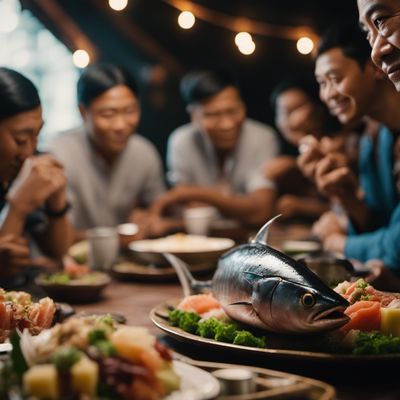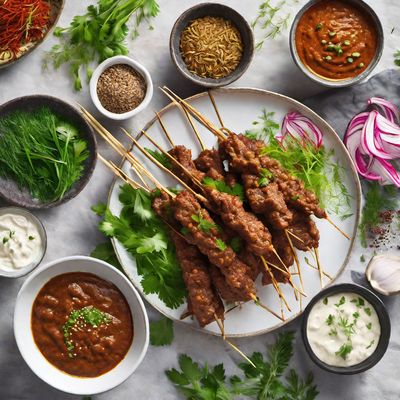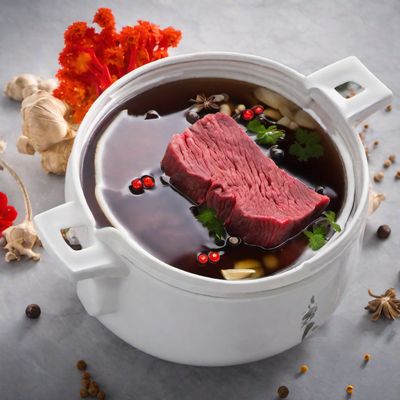
Recipe
Molecular Gastronomy Satay
Satay Reimagined: A Molecular Gastronomy Delight
4.7 out of 5
In the realm of molecular gastronomy, we transform the traditional Indonesian satay into a visually stunning and innovative dish. By utilizing scientific techniques and modern culinary artistry, we elevate the flavors and textures of the classic satay, creating a unique and unforgettable dining experience.
Metadata
Preparation time
60 minutes
Cooking time
60 minutes
Total time
120 minutes
Yields
2 servings
Preparation difficulty
Medium
Suitable for
Vegetarian, Vegan, Gluten-free, Dairy-free, Nut-free
Allergens
Soy, Peanuts
Not suitable for
Paleo, Keto, Low-carb, High-protein, Atkins
Ingredients
While the original Indonesian satay is typically skewered and grilled, our molecular gastronomy version focuses on deconstructing the dish and presenting it in a new and exciting way. We use cutting-edge techniques to manipulate ingredients and textures, resulting in a visually striking and avant-garde interpretation of the traditional satay. We alse have the original recipe for Satay, so you can check it out.
-
200g (7 oz) chicken breast, sous vide 200g (7 oz) chicken breast, sous vide
-
50g (1.8 oz) peanut butter powder 50g (1.8 oz) peanut butter powder
-
20g (0.7 oz) soy sauce caviar 20g (0.7 oz) soy sauce caviar
-
10g (0.35 oz) lemongrass foam 10g (0.35 oz) lemongrass foam
-
5g (0.18 oz) ginger gel 5g (0.18 oz) ginger gel
-
5g (0.18 oz) chili oil pearls 5g (0.18 oz) chili oil pearls
-
2g (0.07 oz) coriander microgreens 2g (0.07 oz) coriander microgreens
Nutrition
- Calories (kcal / KJ): 350 kcal / 1465 KJ
- Fat (total, saturated): 20g, 4g
- Carbohydrates (total, sugars): 15g, 5g
- Protein: 25g
- Fiber: 3g
- Salt: 2g
Preparation
-
1.Sous vide the chicken breast at 65°C (149°F) for 1 hour until tender and juicy.
-
2.Once cooked, slice the chicken breast into thin strips.
-
3.Prepare the peanut butter powder by dehydrating peanut butter and grinding it into a fine powder.
-
4.Using a molecular gastronomy technique, create soy sauce caviar by dropping small droplets of soy sauce into a calcium chloride bath.
-
5.Prepare the lemongrass foam by blending lemongrass with water and straining the mixture. Add soy lecithin and use a handheld blender to create a foam.
-
6.Create ginger gel by blending ginger with water, straining, and adding agar-agar. Allow the mixture to set in the refrigerator before cutting into small cubes.
-
7.Make chili oil pearls by mixing chili oil with sodium alginate and dropping small droplets into a calcium chloride bath.
-
8.Assemble the dish by arranging the chicken strips on a plate. Sprinkle peanut butter powder over the chicken. Add dollops of lemongrass foam, ginger gel cubes, and chili oil pearls. Garnish with coriander microgreens.
Treat your ingredients with care...
- Chicken breast — Ensure the chicken breast is properly cooked and tender by using a sous vide technique.
- Peanut butter powder — Dehydrate the peanut butter thoroughly to achieve a fine powder consistency.
- Soy sauce caviar — Use a dropper to create small droplets of soy sauce and carefully drop them into the calcium chloride bath to form caviar-like spheres.
- Lemongrass foam — Strain the lemongrass mixture well to remove any fibrous pieces before adding soy lecithin to create a stable foam.
- Ginger gel — Allow the ginger mixture to set completely in the refrigerator before cutting it into small cubes for a firm gel texture.
Tips & Tricks
- Experiment with different flavors for the foam, such as lemongrass and lime or ginger and orange, to add complexity to the dish.
- Use a syringe to create precise drops for the soy sauce caviar and chili oil pearls.
- Garnish the plate with edible flowers or microgreens to enhance the visual appeal of the dish.
- Serve the satay with a side of molecular gastronomy-inspired dipping sauces, such as balsamic vinegar pearls or truffle-infused mayonnaise.
- Have fun with presentation by using unique serving vessels or plating techniques to further elevate the dining experience.
Serving advice
Serve the Molecular Gastronomy Satay as an appetizer or as part of a tasting menu. Encourage guests to explore the different elements of the dish by combining flavors and textures. Provide small spoons or forks for easy sampling.
Presentation advice
Create an artistic presentation by arranging the chicken strips in a linear pattern on the plate. Place the foam, gel cubes, and pearls strategically around the plate, creating a visually appealing composition. Garnish with coriander microgreens for a pop of color.
More recipes...
For Satay » Browse all
For Indonesian cuisine » Browse all

Nasi Bogana with Spiced Chicken and Fragrant Coconut Rice
Indonesian Delight: Fragrant Coconut Rice with Spiced Chicken - Nasi Bogana

Indonesian Tumpeng: A Celebration of Flavors and Colors
Tumpeng: A Vibrant Indonesian Feast

Grilled Bakso with Spicy Peanut Sauce
Flame-Grilled Bakso: A Fiery Twist on Indonesian Delicacy
More Indonesian cuisine dishes » Browse all

Sop saudara
Sop saudara is a traditional Indonesian soup made with beef and vegetables.

Cakalang fufu
Smoked Skipjack Tuna
Cakalang fufu is a traditional Indonesian dish that is made with smoked skipjack tuna. It is a flavorful and spicy dish that is perfect for seafood lovers.

Singkong goreng
Fried cassava
Singkong goreng is an Indonesian snack made from cassava that is fried until crispy.








